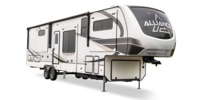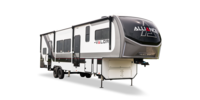A cash-saving option, camping on Bureau of Land Management territory can immerse RVers in nature, miles from the next traveler. Depending on the location, BLM land may include familiar amenities or none at all, making an ideal setting for boondockers seeking dry camping conditions. Before exploring BLM land, here’s what to know about the agency’s history, guidelines, mission and offerings.
ABOUT THE BLM
The BLM was established in 1946 by President Harry S. Truman through a merging of the General Land Office and the Grazing Service. Its mission is "to sustain the health, diversity and productivity of the public lands for the use and enjoyment of present and future generations."
The agency manages more land (245 million surface acres or one-tenth of America’s land base) and more subsurface mineral estate (700 million acres) than any other government unit. Uses for BLM land include mining, ranching, recreation, timber harvesting and energy development. The BLM is also responsible for the conservation of natural, historical and cultural resources such as wilderness areas, wildlife habitats, artifacts and dinosaur fossils.
Though the BLM oversees land throughout the country, the majority of BLM public lands are located in 12 western states: Alaska, Arizona, California, Colorado, Idaho, Montana, Nevada, New Mexico, Oregon, Utah, Washington and Wyoming.
DEVELOPED CAMPGROUNDS
BLM land includes developed campgrounds with amenities such as restrooms, potable water, electrical hook-ups, shelters, picnic areas and more. Most BLM campgrounds require a fee to use a campground, which helps maintain the facility. Fee sites vary in price; campers should check the campground’s website or call the local field office for details.
While most campgrounds are available on a first-come, first-serve basis, some campgrounds accept reservations, which can be made through recreation.gov.
DISPERSED CAMPING
Dispersed camping (also called boondocking, dry camping or wild camping) occurs outside of sanctioned campgrounds, typically in isolated areas.
Boondocking is a great cash-saving choice for RVers seeking the road less traveled or making last-minute decisions, as there are no reservations or fees required.
BLM Public Lands are areas with no designation, purpose or protections. Public Lands will likely not have signage or amenities.
Travelers should contact the regional ranger station prior to arrival to determine open territories and avoid camping on private land.
HOW TO FIND BLM LAND
The BLM offers several maps and apps to locate and learn about agency land; pinpoint trailheads, recreation opportunities, off-highway vehicle areas, information centers and more.
One of several non-government apps, FreeRoam allows RVers to easily locate BLM and Unites States Forest Service land, with map overlay functions and search filters, such as reviews, rig length, crowdedness, road difficulty, shade, safety and noise. Campers should also consider carrying paper maps as there is limited cellular service in many BLM territories.
When choosing a campsite, especially for boondocking, researching others’ reviews and talking to locals can help prepare RVers for what to expect in unfamiliar backcountry.
BLM CAMPING LIMITS
Though each BLM State Office and each BLM Field Office is free to adopt its own camping limits, most still use the 14-day rule, created to reduce human impact on the land (the rule is applied mostly to Public Lands and not established campgrounds). Campers may stay a maximum of 14 days in a 28-day period within a 25-mile radius.
- The 28-day period begins once camp is erected.
- Once campers exhaust those 14 days, they cannot return to the same area until after the 28-day period expires.
It’s not uncommon for boondockers to exceed the 14-day limit, as BLM officers rarely enforce the rule and usually saddled with larger problems to address. However, it’s best practice among campers to adhere to signage and the rules of the land.
Additionally, campers may leave their personal property unattended for up 10 days on most BLM Public Lands (12 months in Alaska).
LEAVE NO TRACE
In helping to preserve the natural beauty of BLM lands, campers should leave no trace. Many BLM areas do not have trash services, making it more imperative for visitors to pack out whatever is packed in.









